Advancements in artificial intelligence (AI) are transforming upper limb prosthetics, making them smarter, more intuitive, and easier to use. For decades, prosthetic hands and arms have relied on mechanical or myoelectric control, requiring users to master complex movements to operate them. Now, with AI, prosthetic technology is becoming more responsive, learning from the user’s habits, and providing a level of functionality that was once unimaginable.
AI-powered prosthetics are not just artificial limbs—they are intelligent systems that adapt, predict, and enhance movement. By integrating machine learning, sensory feedback, and real-time motion analysis, these prosthetics are closing the gap between human capability and robotic assistance.
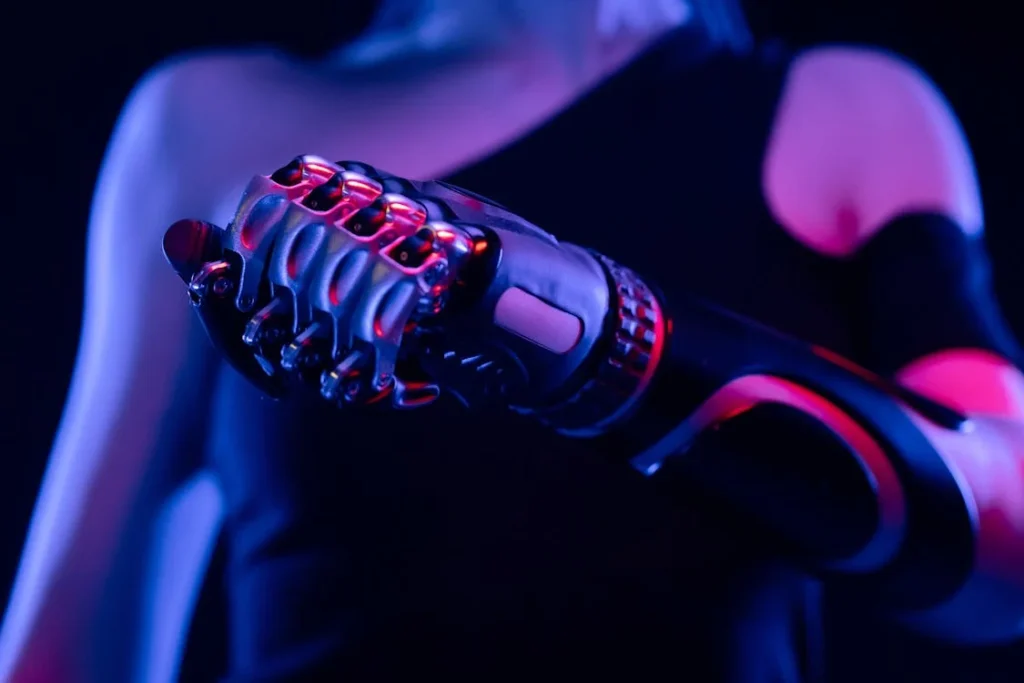
How AI is Transforming Prosthetic Control
The biggest challenge with prosthetic hands and arms has always been control.
Traditional prosthetics require the user to manually operate them through body movements or muscle contractions.
While myoelectric prosthetics—those that respond to electrical signals from the muscles—have improved functionality, they still require significant training.
AI is solving this issue by making prosthetic control more natural, intuitive, and responsive.
Learning from the User’s Movements
AI-driven prosthetics use machine learning algorithms to understand a user’s movement patterns over time.
Instead of requiring constant manual adjustments, these systems can predict what the user intends to do.
This means that as a person repeatedly performs an action, the prosthetic hand learns how to replicate the movement more efficiently.
For example, if a user frequently picks up a coffee cup in a certain way, the AI will recognize the motion and automatically adjust the grip force and hand position.
Over time, the prosthetic will require less conscious effort from the user, making everyday tasks much easier.
Improving Grip Precision and Strength
One of the biggest limitations of traditional prosthetic hands is grip control. Many users struggle with applying the right amount of pressure when holding objects.
AI is helping prosthetics automatically adjust grip strength based on the object being held.
By analyzing data from sensors embedded in the prosthetic fingers, AI can determine the size, weight, and texture of an object.
This allows the prosthetic to apply just the right amount of force, preventing fragile objects from being crushed while ensuring a firm grip on heavier items.
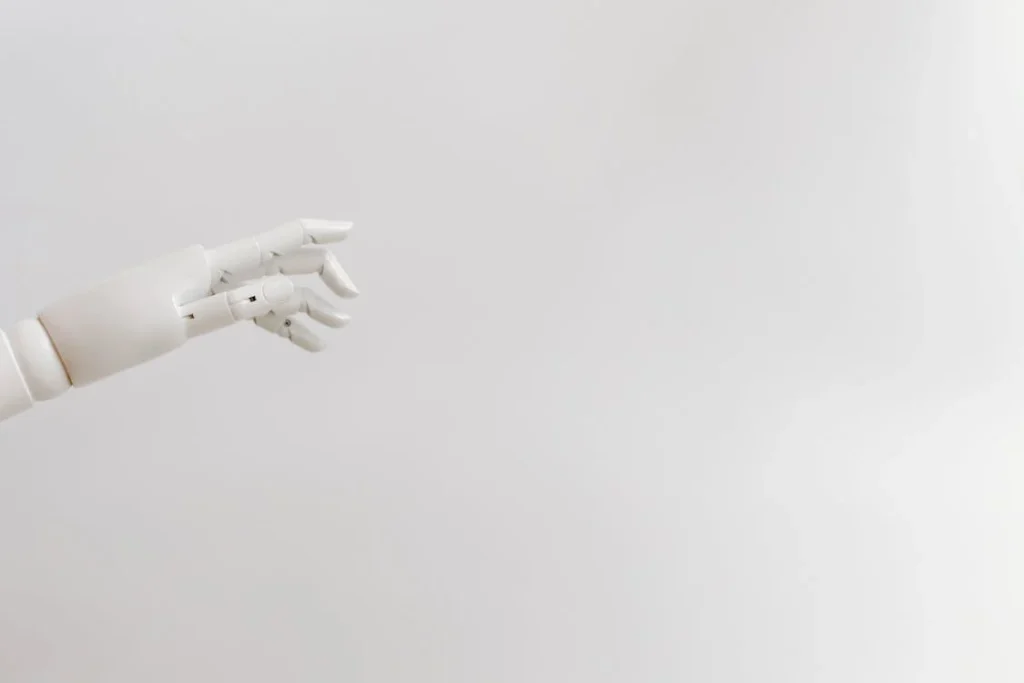
Restoring the Sense of Touch with AI
One of the most groundbreaking advancements in AI-powered prosthetics is the development of sensory feedback systems.
Traditional prosthetic hands, even myoelectric ones, do not provide a sense of touch.
This means that users rely entirely on visual cues and muscle memory to control their movements.
AI is now being used to bridge the gap between human sensation and robotic function, giving users a more natural experience.
How AI-Enabled Sensory Feedback Works
Prosthetic hands equipped with AI use sensors embedded in the fingertips and palm to detect pressure, texture, and temperature.
These sensors send signals to a microprocessor, which processes the information in real time.
The AI then translates this data into electrical impulses that are sent to the user’s nervous system, creating an artificial sense of touch.
Some advanced systems even use haptic feedback, where small vibrations or electrical pulses stimulate the skin, mimicking the sensation of contact.
The result is a prosthetic that allows users to “feel” what they are touching.
A user can tell the difference between holding a soft piece of fabric and a hard plastic cup, which dramatically improves control.
This technology also enhances safety, as users can sense if they are applying too much force when gripping fragile objects.
Enhancing Coordination and Dexterity
AI-driven sensory feedback helps users develop better coordination and dexterity.
Without touch, prosthetic users often rely on visual monitoring to adjust their grip, which slows down movements and makes multitasking difficult.
With AI processing sensory input, users can perform tasks more naturally and efficiently.
For example, tying shoelaces, which requires precise finger movements, becomes more manageable with sensory feedback.
Writing with a pen, holding a smartphone, or even shaking hands with someone feels more intuitive.
These improvements give users greater independence and confidence in their daily activities.
Reconnecting the Brain to the Prosthetic
Researchers are also exploring ways to integrate AI-driven prosthetics directly with the brain through neural interfaces.
By detecting electrical signals from the brain, AI can translate thoughts into prosthetic movements without the need for muscle contractions.
This development could revolutionize prosthetics for people with high-level amputations, spinal cord injuries, or nerve damage.
These brain-controlled prosthetics rely on AI algorithms that continuously learn from the user’s intentions, improving accuracy and speed over time.
Although this technology is still in its early stages, it holds the promise of making prosthetic limbs feel like a true extension of the body.
At Robobionics, we are closely following these advancements and working towards integrating AI-driven sensory feedback into our prosthetic solutions.
The goal is to create prosthetic hands that not only restore movement but also bring back the experience of touch, making them more lifelike and functional than ever before.
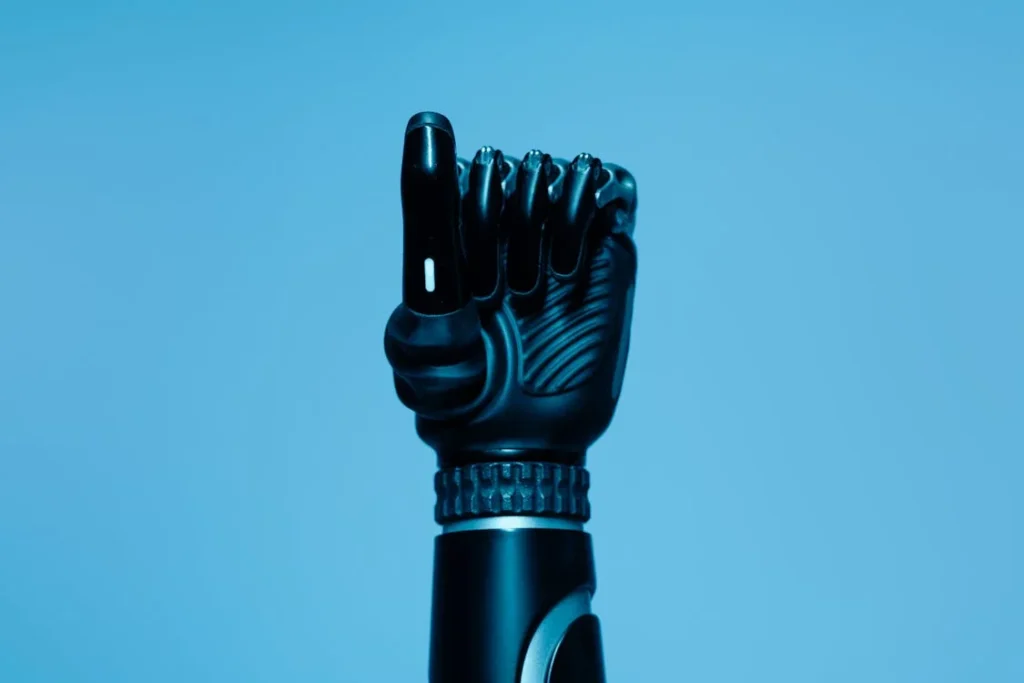
AI and Adaptive Learning in Prosthetics
AI is not only improving control and sensory feedback but also enabling prosthetic hands to learn and adapt over time.
Traditional prosthetics function based on fixed movements, requiring the user to consciously control every action.
With AI-driven adaptive learning, prosthetics are becoming smarter, adjusting to a user’s specific habits, preferences, and daily routines.
How Adaptive Learning Works
AI-powered prosthetic hands are equipped with machine learning algorithms that analyze data from muscle signals, movements, and usage patterns.
Instead of simply reacting to muscle contractions, the AI system processes past actions to predict what the user intends to do.
For instance, if a person regularly picks up a fork in a certain way, the prosthetic will begin to anticipate the motion and adjust the grip accordingly.
Over time, this reduces the amount of effort needed from the user. Instead of thinking about each movement, the prosthetic automatically refines its response, making actions feel smoother and more natural.
Another key advantage of adaptive learning is its ability to adjust grip strength based on past interactions.
If a user frequently handles delicate objects like glassware, the AI will recognize the pattern and apply a gentler touch when similar objects are detected in the future.
Likewise, for heavier objects, the prosthetic can automatically increase grip strength to prevent accidental slips.
Personalized Movement Patterns
Every person uses their hands in a unique way. The way someone writes, holds a cup, or carries a grocery bag is different from another person’s style.
AI-driven prosthetics take this individuality into account, allowing for fully personalized movement patterns.
Instead of forcing users to adapt to a pre-programmed prosthetic hand, AI learns from the user’s natural behavior and adjusts accordingly.
This means that two people using the same AI-powered prosthetic could have completely different movement responses tailored to their specific needs.
Adaptive learning also helps people who are new to using prosthetics. For first-time users, learning to control a prosthetic hand can be challenging.
AI simplifies this process by offering real-time feedback and automatic adjustments, reducing the learning curve and helping users feel more comfortable and confident with their device.
Continuous Improvements Through Software Updates
One of the biggest advantages of AI-driven prosthetics is that they are not limited to their original programming.
Just like a smartphone or a computer, AI-powered prosthetic hands can receive software updates that improve functionality over time.
Manufacturers can introduce new grip modes, enhanced sensitivity settings, or even entirely new movement patterns through simple software upgrades.
Instead of requiring users to buy a completely new prosthetic, updates can be installed remotely, ensuring that the device remains up-to-date with the latest advancements.
At Robobionics, we recognize the potential of AI-powered adaptive learning in prosthetics.
By combining intelligent motion analysis with user-specific learning, we aim to create prosthetic solutions that continuously improve with time, allowing users to enjoy seamless control and greater independence.
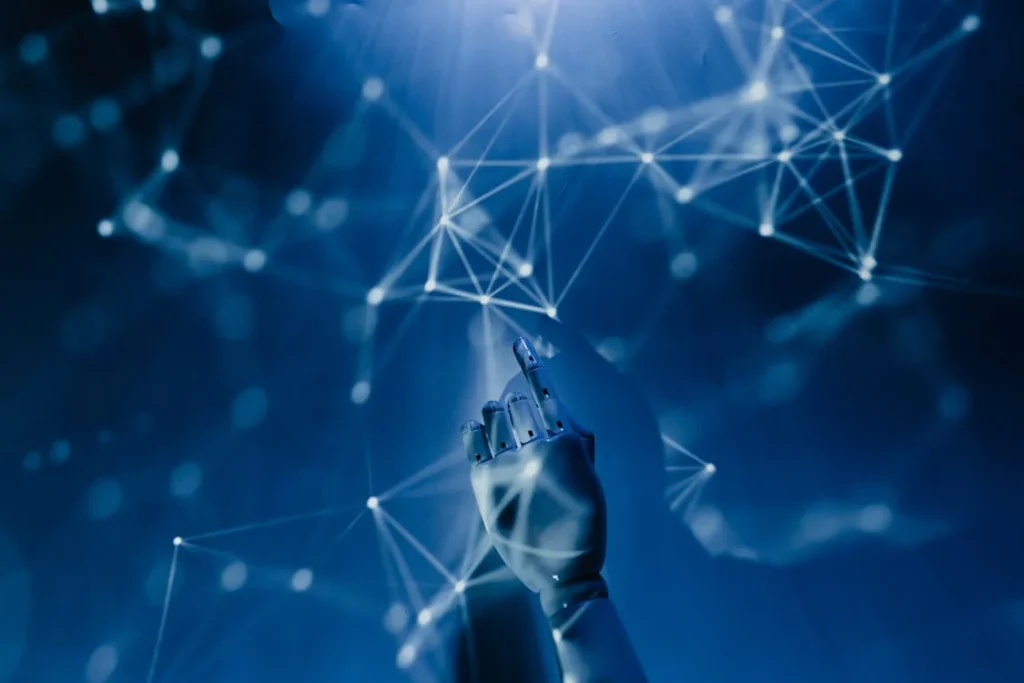
The Role of AI in Reducing Prosthetic Fatigue
One of the biggest challenges for upper limb prosthetic users is fatigue. Controlling a prosthetic hand, especially a myoelectric one, requires constant muscle engagement.
Over time, this can lead to strain, discomfort, and even frustration. AI is helping to address this problem by making prosthetic control more efficient, reducing the effort required from the user.
Understanding Prosthetic Fatigue
For people using body-powered prosthetics, fatigue comes from the physical effort needed to operate cables and harnesses.
For those with myoelectric prosthetics, the challenge is different. Since these devices rely on muscle signals to trigger movements, the user must constantly contract specific muscles to perform even simple tasks.
This can become tiring, especially when performing repetitive motions throughout the day.
Many users also experience mental fatigue. Traditional prosthetic hands require constant focus to ensure precise movements.
Without direct sensory feedback, users must visually monitor their prosthetic at all times, adding to the cognitive load. Over time, this can make even small tasks feel exhausting.
AI-Powered Movement Assistance
AI is improving prosthetic function by reducing the amount of effort needed to operate the device.
Through predictive modeling and adaptive control, AI-driven prosthetics can anticipate movements and assist the user by adjusting grip strength, hand positioning, and overall responsiveness.
For example, instead of requiring a user to fully contract their muscles to open and close the hand, AI can recognize partial signals and amplify them.
This means that a lighter muscle contraction can trigger the same movement, reducing strain on the muscles and making the prosthetic easier to use for extended periods.
Additionally, AI-powered hands can recognize repetitive tasks and automate them when necessary.
If a user frequently types on a keyboard, the prosthetic can optimize finger positioning to reduce unnecessary effort.
Similarly, for activities like holding a phone or carrying a bag, the AI can maintain grip without requiring constant muscle engagement from the user.
Dynamic Energy Efficiency
Many prosthetic hands run on battery power, and energy consumption has always been a concern.
AI is helping to make prosthetics more energy-efficient by dynamically adjusting power usage based on real-time activity.
Instead of operating at full power all the time, AI algorithms can determine when to conserve energy and when to increase motor strength.
This technology not only extends battery life but also ensures that users experience smoother, more natural movement.
By balancing power consumption with functional demand, AI reduces the likelihood of the prosthetic shutting down unexpectedly due to battery drain.
At Robobionics, we are integrating AI-based energy management and movement optimization into our prosthetic solutions.
By reducing both muscle and mental fatigue, we aim to make prosthetic hands that are more comfortable and effortless to use throughout the day.
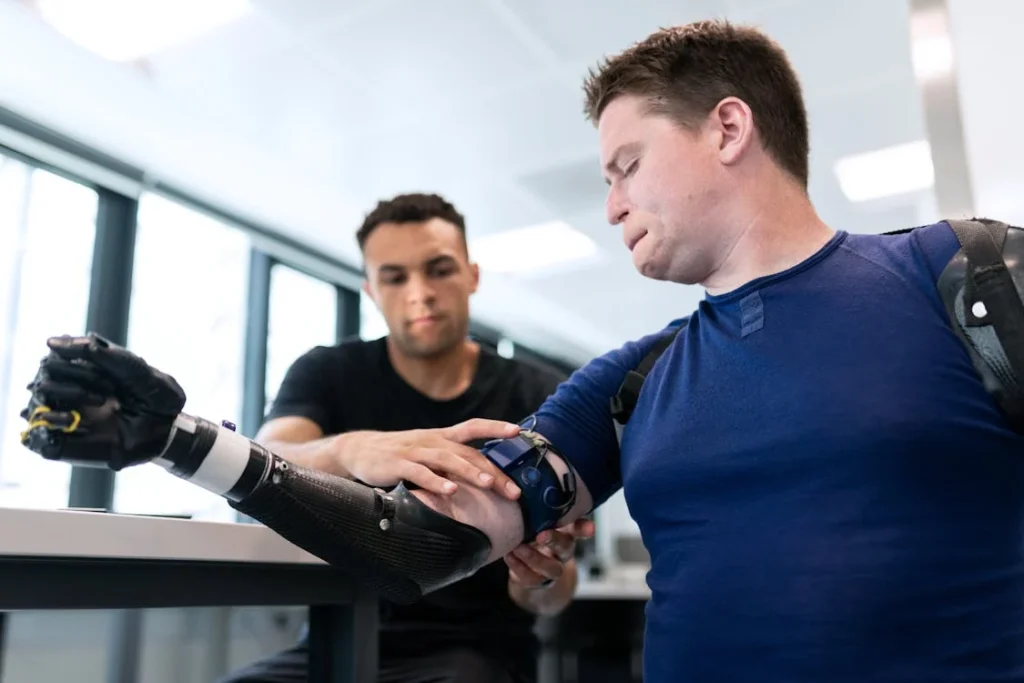
The Impact of AI on Prosthetic Training and Rehabilitation
Adapting to an upper limb prosthetic requires time, patience, and practice. For new users, learning how to control a prosthetic hand can feel overwhelming.
Even those who have used prosthetics for years often face challenges when upgrading to newer, more advanced models.
AI is transforming the training and rehabilitation process by making it easier, faster, and more personalized.
Personalized Training for Faster Adaptation
Traditional prosthetic training involves working with a therapist to practice different grip patterns, muscle contractions, and everyday tasks.
While this method is effective, it can take weeks or even months before a user feels fully comfortable with their device.
AI is speeding up this process by learning from the user’s natural movement patterns and providing real-time feedback and guidance.
By analyzing muscle signals and tracking motion accuracy, AI-powered prosthetics can identify mistakes and suggest corrections without the need for constant supervision from a therapist.
This means that users can practice at home with greater confidence, allowing them to improve their control skills at their own pace.
AI also adjusts to the user’s learning curve, making small changes to movement sensitivity and grip strength based on how quickly they adapt.
Gamified Rehabilitation for a More Engaging Experience
One of the biggest obstacles in prosthetic rehabilitation is maintaining motivation.
Repetitive training exercises can become tedious, making it harder for users to stay engaged.
AI is helping to solve this issue by incorporating gamification into prosthetic training.
Through interactive virtual environments and AI-driven exercises, users can practice using their prosthetic in a fun, engaging way.
These programs often include real-time progress tracking, encouraging users to meet small goals while gradually improving their prosthetic control.
Some AI-powered prosthetics can even connect to mobile apps, allowing users to complete training exercises through a smartphone interface.
At Robobionics, we have developed gamified home-based rehabilitation programs that make prosthetic training more enjoyable and effective.
By combining AI with engaging exercises, users can build muscle strength, improve coordination, and develop confidence in using their prosthetic hand.
Continuous Learning and Skill Development
Unlike traditional training programs that remain static, AI-driven prosthetic systems continue to learn and evolve with the user.
As a person becomes more skilled in using their prosthetic, AI can introduce new challenges and movement refinements to help them master more complex tasks.
For example, an AI-powered prosthetic hand may start with basic grip functions, gradually allowing the user to perform more intricate movements like typing, playing an instrument, or cooking.
This ensures that the prosthetic remains useful as the user’s abilities grow.
AI is making rehabilitation smarter, faster, and more personalized, ensuring that prosthetic users receive the best possible support as they regain control over their daily lives.
At Robobionics, we are committed to integrating these innovations into our prosthetic solutions, helping users adapt quickly and confidently.
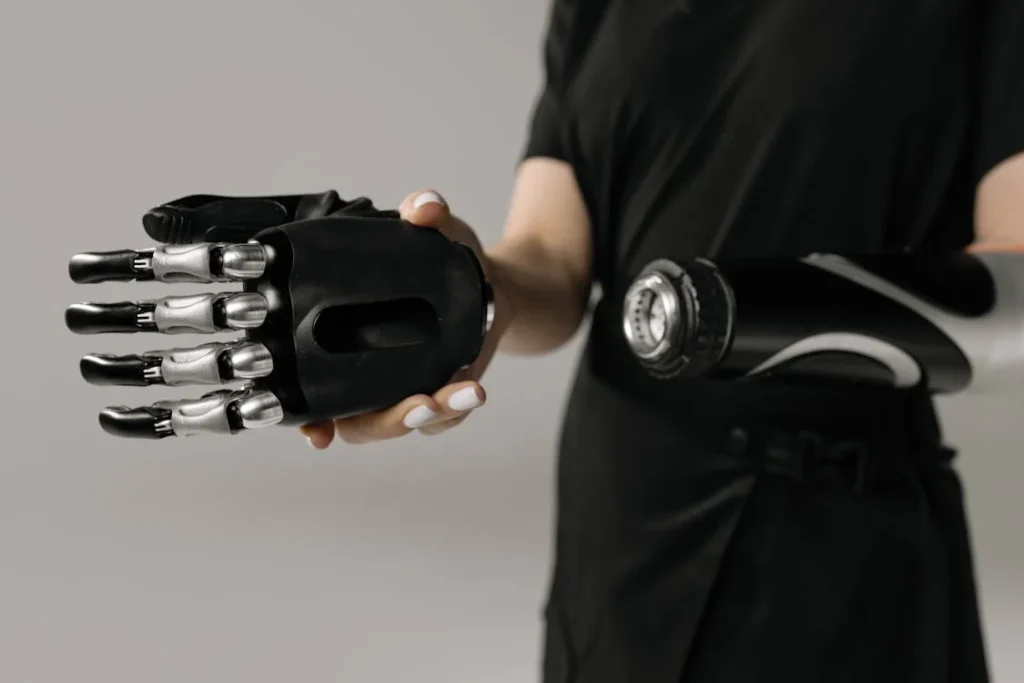
The Role of AI in Enhancing Prosthetic Longevity and Maintenance
For many prosthetic users, durability and maintenance are ongoing concerns. Traditional prosthetic hands and arms require regular servicing, and if a critical component fails, repairs can be costly and time-consuming.
AI is addressing these issues by making prosthetics more self-sufficient, capable of predicting maintenance needs, and even diagnosing mechanical issues before they become major problems.
Predictive Maintenance and Self-Diagnosis
One of the biggest advancements AI brings to prosthetics is the ability to predict when repairs or adjustments are needed.
Just like modern cars use onboard sensors to detect potential issues, AI-powered prosthetic hands are now being equipped with self-monitoring systems that track usage patterns and component wear.
If a motor starts to slow down, a joint becomes stiff, or a sensor is not responding correctly, AI can detect these small changes before they turn into larger failures.
Instead of waiting for a breakdown, users can be alerted through a smartphone app or a notification on the prosthetic itself, prompting them to schedule maintenance at the right time.
This not only prevents unexpected failures but also extends the lifespan of the device.
Remote Troubleshooting and Software Upgrades
Traditional prosthetic repairs often require in-person visits to a specialist, which can be inconvenient for users who live in remote areas.
AI is making it possible for many troubleshooting and adjustments to be handled remotely.
Smart prosthetic systems can diagnose their own technical issues and recommend solutions without requiring a technician to inspect the device in person.
For example, if a grip function is not responding correctly, AI can analyze the problem and adjust the calibration automatically.
If a deeper issue is detected, users can receive detailed guidance on what steps to take next.
Some AI-driven prosthetics are even designed to receive wireless software updates, introducing performance improvements without the need for physical modifications.
At Robobionics, we are integrating AI-powered diagnostic tools into our prosthetic solutions, ensuring that users have access to real-time maintenance support and continuous software upgrades.
This helps keep prosthetic hands functioning at their best without unnecessary downtime.
Reducing Costs and Increasing Accessibility
Prosthetic maintenance and repairs have traditionally been expensive, with replacement parts and servicing fees adding to the overall cost of ownership.
AI is helping to reduce these expenses by automating many of the maintenance tasks that previously required professional intervention.
By predicting wear and tear before it leads to mechanical failure, AI-driven prosthetics minimize the need for costly emergency repairs.
This is especially important for users who rely on their prosthetic for daily activities and cannot afford long waiting periods for replacements.
Additionally, AI-powered prosthetic hands are being designed with modular components, meaning that individual parts can be replaced easily without requiring a full prosthetic overhaul.
Combined with AI’s ability to track part durability, this approach makes prosthetics more sustainable, cost-effective, and accessible in the long run.
AI is transforming prosthetic longevity and maintenance, ensuring that users experience greater reliability, lower costs, and fewer disruptions.
At Robobionics, we believe that proactive, AI-driven solutions are the future of prosthetic care, making high-quality, long-lasting prosthetics available to more people than ever before.
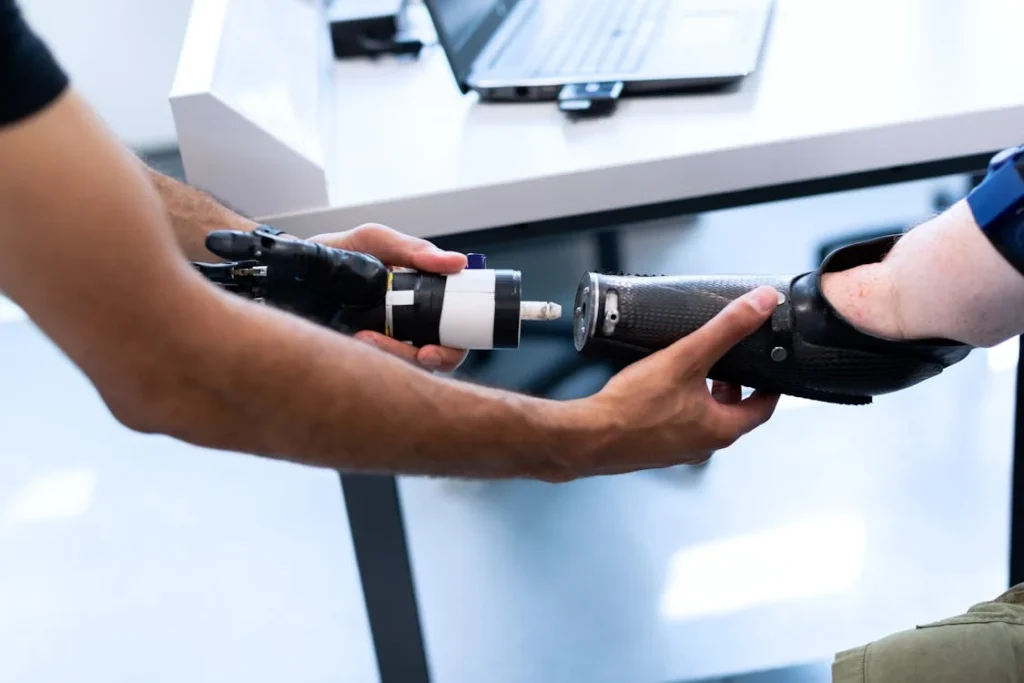
The Ethical and Psychological Impact of AI in Prosthetics
As AI-powered prosthetics become more advanced, the conversation is no longer just about functionality.
These intelligent devices are changing the way people with limb loss perceive themselves and interact with the world.
AI-driven prosthetic hands are not just tools—they are becoming part of the user’s identity, raising important ethical and psychological questions.
Redefining Human-Machine Integration
AI prosthetics blur the line between human ability and robotic enhancement. Unlike traditional prosthetics that simply replace lost function, AI-powered hands actively learn, adapt, and even anticipate movements.
This raises an important question: where does the prosthetic end and the person begin?
For some users, the ability to control an AI-driven prosthetic with greater ease creates a deeper sense of connection with the device.
Over time, the prosthetic starts to feel like an extension of their body, reducing feelings of loss or limitation.
However, for others, the idea of relying on AI for movement and decision-making can feel unsettling, as it introduces a level of machine autonomy that was previously unheard of in prosthetic technology.
The challenge lies in ensuring that AI remains a supportive tool rather than replacing human agency.
A prosthetic should enhance a person’s natural movements and intentions, not override them. This is why AI in prosthetics must be designed with a user-first approach, focusing on adaptability without taking away control from the wearer.
The Psychological Impact of AI-Driven Prosthetics
One of the most overlooked aspects of prosthetic technology is the psychological adjustment required to use it effectively.
Traditional prosthetic users often experience emotional hurdles when adapting to their devices. AI prosthetics introduce new complexities, as users must learn to trust a machine that is actively learning from them.
Some users may feel empowered by the intelligence and adaptability of their prosthetic, experiencing a renewed sense of independence and confidence.
Others may struggle with feeling different, especially if their prosthetic moves in ways that seem too robotic or unnatural.
To address these concerns, AI-driven prosthetics must be designed to prioritize natural movement and intuitive control.
The more seamless and organic the prosthetic feels, the easier the psychological transition will be.
Additionally, rehabilitation programs that include emotional support and peer mentorship can help new users navigate the mental and emotional aspects of using an AI-powered prosthetic.
Ethical Considerations and Accessibility
As AI-driven prosthetics become more sophisticated, ethical questions arise about who has access to these advanced devices.
If AI prosthetics significantly outperform traditional ones, will there be a divide between those who can afford them and those who cannot?
Prosthetic technology should be developed with accessibility in mind, ensuring that advancements in AI do not create further inequality.
At Robobionics, we are committed to making affordable AI-powered prosthetic solutions available to as many people as possible, ensuring that cost and technology gaps do not limit access to life-changing innovations.
The integration of AI into prosthetics is not just about restoring movement—it is about reshaping the relationship between humans and machines.
As this technology continues to evolve, it is essential to balance progress with ethical responsibility, ensuring that AI serves to empower users rather than replace their sense of control and identity.
Conclusion
AI is transforming upper limb prosthetics, making them more intuitive, adaptive, and personalized than ever before. By learning from user movements, improving grip precision, and even restoring a sense of touch, AI is bridging the gap between artificial limbs and natural function. It is not just about improving technology—it is about enhancing the quality of life for prosthetic users.
From reducing fatigue to enabling real-time maintenance and gamified rehabilitation, AI-driven prosthetics are redefining what is possible. These advancements bring greater independence, confidence, and ease of use, allowing users to interact with the world more naturally. However, as AI becomes more integrated into prosthetics, ethical considerations and accessibility must remain a priority to ensure that these life-changing innovations are available to everyone who needs them.
At Robobionics, we are committed to developing AI-powered prosthetic solutions that are affordable, reliable, and empowering. By combining cutting-edge technology with a user-first approach, we aim to make next-generation prosthetics a reality for more people worldwide. If you are looking for an advanced, AI-driven prosthetic hand, explore our solutions today and take the next step toward a more independent future.



